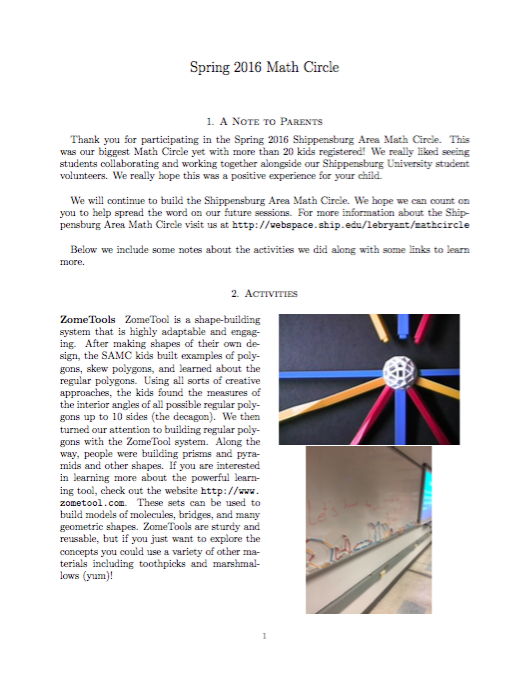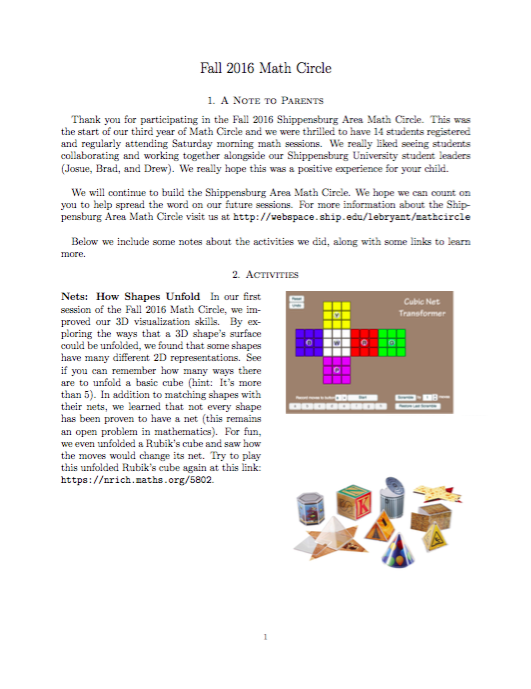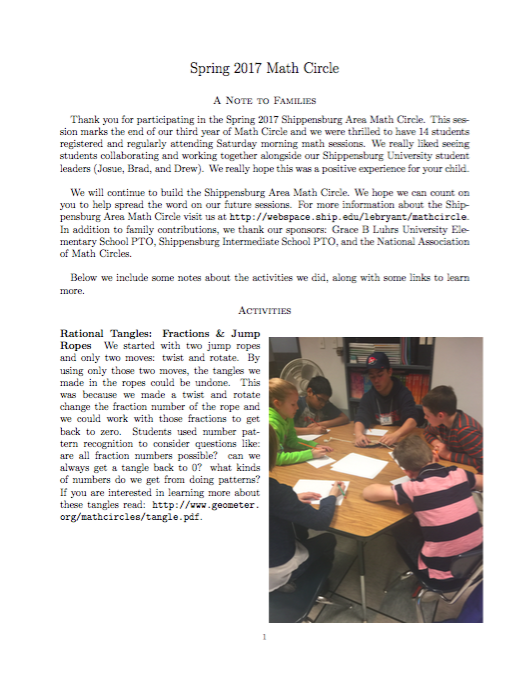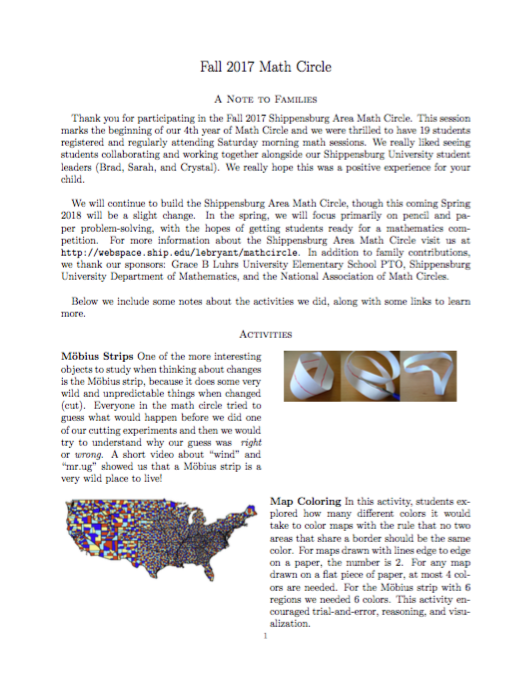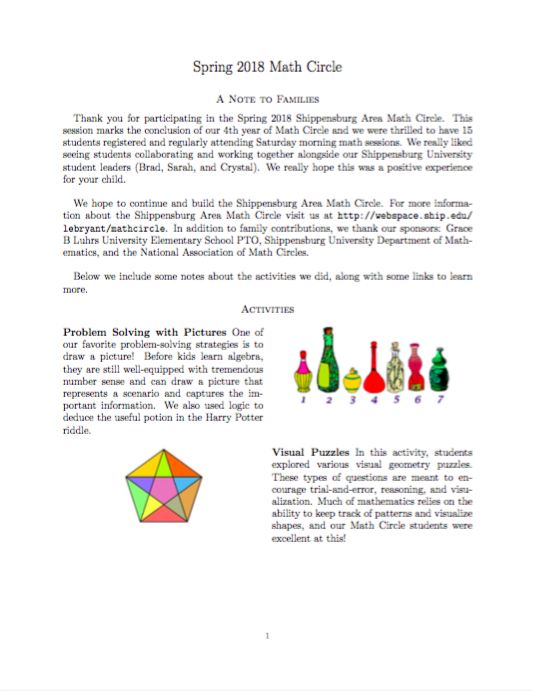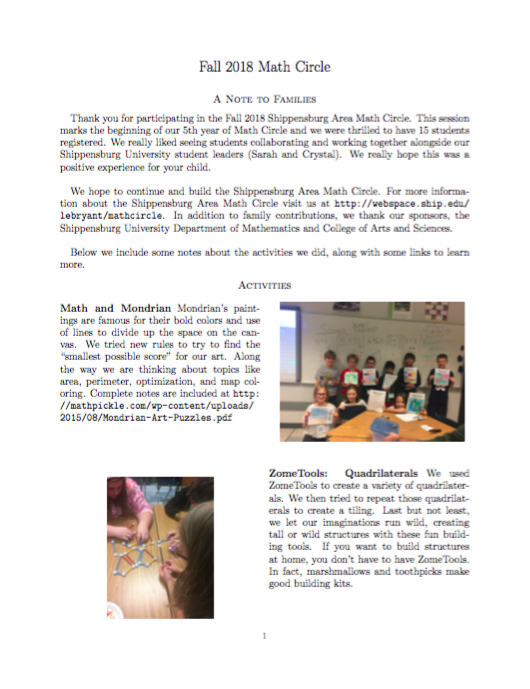Overview of the Sessions and Activities
Calculus on Skis. We all enjoy having fun in the snow. Math Circle student leader Josue Murillo used a simple example of a skier going up and down mountains to introduce some key ideas in calculus. The students worked on examples leading toward a definition of the slope of a tangent line.
Candy Sharing Game. In this game the leader distributed “candy” among players. When the leader said “Share!” each person who had two or more pieces of candy gave one piece to the person on their right and one to the person on their left. After that round of sharing was done, the leader would say “Share!” again and the process would repeat until the group saw a pattern. This was an easy collaborative game that allowed everyone to try different strategies for producing patterns (like a terminator, a fixed point, and a cycle). These are patterns mathematicians are interested in when examining any repeating process. Handout for students: Candy Sharing Game.
Circles and Dots. We used this activity to make observations and conjectures about what happens when we make shapes by moving around a circle. The students made conjectures about how the same shape can be made when looking at multiples of a number. Some students got creative and made circles with lots of dots and wild jump patterns. By recording their work and thoughts, students got a taste of what mathematics research is like! Website with some info: Connect the dots.
Codes and Ciphers. Spies are not the only ones who need to know about secret codes. In everyday life, codes are used to send information around the internet and keep important information safe. We learned about Caesar ciphers, Masonic (pigpen) ciphers, scytales, and morse code. Then we used those codes to complete a scavenger hunt around the math building. Everyone worked together to earn their Math-O-Ween treats. Good teamwork, Math Circle! Handout for students: Cryptography Toolkit.
Exploding Dots. Expoding dots is a lot safer than it sounds. In this topic, the main idea is really about changing bases. In our every day world, we think in base 10. After all, look at our hands…it’s pretty natural for us to count things in groups of ten. However, computers don’t have fingers and they “think” in terms of 0’s and 1’s. We learned that for a 1←2 machine, dots explode and let us change any number into a code number using only 0’s and 1’s. We used some of the shortcuts that this method revealed to do quick multiplication, too. There are many more activities and ways of playing with exploding dots at mathematician James Tanton’s website.
Fraction Tangles. This activity is usually called Rational Tangles. In 1967, mathematician John H. Conway presented seminal results on the classification of knots through a study of “rational tangles.” In order to explain some of key ideas behind the theory, he developed an activity, the “rational tangle dance,” that four people holding the ends of two lengths of rope can perform. The magic of this activity has captivated many over the decades, and the rational tangle dance is a now considered a favorite in many math circle groups. We did our own version based on a paper by Tom Davis, and students got plenty of practice adding fractions and taking reciprocals.
Hexagons. Hexagons are one of nature’s coolest shapes- ask any bee! One thing that makes hexagons special is their ability to tile a plane, covering any surface efficiently. Hexagons are also very strong, as we found when we “built” a beehive out of hexagonal prisms. We also saw a way to make a regular hexagon using only a compass and straightedge. Two of the activities we did this day were based on the mathematical writings of Martin Gardner, a famous popularizer of recreational mathematics. The trihexaflexagon and the board game Hex are both topics he wrote about. In the 1950s, Gardener said the game “Hex may well become one of the most widely played and thoughtfully analyzed new mathematical games of the century.” And it’s true that Hex has captured the interest of mathematicians for years! Try playing a game using a printable board.
Impossible Cylinders. Inspired by the amazing designs of engineering professor Kokichi Sugihara, we made some impossible cylinders. These cylinders seemed to change shape before our very eyes! They are not actually impossible, instead, each relied on using forced perspective to see things differently. Sugihara’s video Ambiguous Optical Illusion received second prize in the Neural Correlate Society’s 2016 best illusion of the year contest. Some instructions to make your own are available at Dave Richeson’s Division by Zero blog.
K’NEX Connections. Shippensburg University Teacher Education department chair and professor, Dr. Christine Royce, led a fun day of building! We got to build K’NEX kits including: towers, DNA models, moving fans, and various shapes. By working at each station, everyone was able to work on three different projects. We loved seeing the teamwork at play here. Dr. Royce has worked with the company K’NEX to create educational kits and lesson plans, and it was a wonderful session.
Map Coloring. In this activity, students explored how many different colors it would take to color maps with the rule that no two areas that share a border should be the same color. We began with edge-to-edge maps and talked about a way (basically, mathematical induction) to show we only need two colors. Then we considered a map of the Western half of the United States to see that in this case we need at least four colors. This of course, brings us to the famous Four Color Theorem. When everyone started to believe we only ever need four colors, we created a map on a Möbius strip and suddenly four colors weren’t enough. We needed six! This activity encouraged trial-and-error, reasoning, and visualization. Notes for facilitators: Map Coloring.
Math and Origami. There are many beautiful shapes that can be made simply by folding paper. We explored examples for three different types of shape creations: modular origami, transforming origami, and paper cutting (kirigami). We discussed the amazing Fold-and-Cut Theorem, which states that any shape with straight-line edges can be cut from a single sheet of paper by folding it flat and making a single straight, complete cut. At the end of the session we watched the excellent fifteen-minute TED talk by Robert Lang about the math and magic of origami. Handouts for students: Puzzling Origami, Transforming Origami, One-Cut Kirigami.
Mathemagic. Sometimes math can be so mysterious it seems like MAGIC. By noticing some patterns, we were able to impress and amaze with our ability to multiple double digit numbers (as long as our pal 37 was involved). We could also form Fibonacci sequences and then add up the first ten terms in no time at all. And that magic gopher? He has been doing his act for a long time (Lance introduced Mr. Gopher to 7th grade students almost ten years ago to the day!). He is cute but it turns out he’s not as magical as he seems. Can you explain how he always knows the symbol? Thanks to Math for Love for their notes on the power of 37, and to Doug Ensley for showing us the Fibonacci trick. Handout for students: The Fibonacci Trick (with bonus mathematical card trick).
Möbius Strips. In this lesson we started with the magical feat of cutting out just the middle of an index card and passing a basketball through it! Have you tried this at home yet? This was an introduction to the idea of topology: the study of the properties of an object that remain unchanged after stretching, shrinking, and/or twisting it. The index card was definitely changed when it was cut, and so a topologist would say that the regular and cut index card are different objects entirely. But a donut and a coffee cup? The same! An interesting object that topolgists go crazy for is the Möbius strip. It does some wild and surprising things when changed (cut). Everyone in the math circle tried to guess what would happen before we did our cutting experiments and then we would try to understand why our guess was right or wrong. Notes for facilitators: Möbius Strips and Wild Topology.
Mondrian Art Puzzles. Piet Mondrian’s paintings are famous for their bold colors and use of lines to divide up space on the canvas. Posing as evil bosses, we imposed new rules on artists like Mondrian to force them to make “cheap” art. Along the way we were thinking about area, perimeter, optimization, and map coloring. Thanks to MathPickle for this wonderful Mondrian art puzzle activity. We are still trying to answer some of the questions that came up during the session, and so is the rest of the mathematical community!
Nets: How Objects Unfold We worked on improving our 3D visualization skills. By exploring the ways that an object’s surface could be unfolded, we found that some shapes have many different 2D representations. How many ways are there to unfold a basic cube? When should we consider two nets for a cube the same? The kids enjoyed the interactive website for cube nets from the National Council of Teachers of Mathematics. In addition to matching shapes with their nets using a Learning Resources kit, we learned that not every shape has been proven to have a net. This remains an open problem in mathematics! For even more fun, we unfolded a Rubik’s cube and saw how the usual moves change its net. If solving a Rubik’s cube is too easy for you, try to solve a Rubik’s cube net.
The Pancake Problem. We were very fortunate to have Dr. Katie Haymaker, Assistant Professor of Mathematics at Villanova University, as a guest for this topic. If you have ever had delicious pancakes for breakfast, you know that it’s nice to have them arranged from largest on the bottom to smallest on top. But what if they don’t start out that way and the only tool you have is a spatula to make flips? What a delicious problem- with cool mathematical applications, including to the field of DNA analysis. If you want to learn more, read an article by Dr. Haymaker (starts on page 16). Handout for students: The Pancake Problem.
River-Crossing Puzzles. This is a classic. Suppose we want to get several people across a river but the boat has restrictions. Students explored how to get people across while following the restrictions. Dr. Marc Renault, a math professor at Shippensburg University, discussed translating this problem into another that involved marking moves on a grid so that a solution would be easier to find. There are many river crossing puzzles at the Math Fair website.
Tic Tac Toe. Sure, everybody has played tic tac toe before. But Dr. Ben Galluzzo, a math professor at Shippensburg University, showed us that the usual tic tac toe is “unfair” to some of the spots on the board- they cannot be in a winning line as often as the middle spot. By changing the rules a bit we were able to make a tic tac toe game where every single spot on the board is as useful as every other spot. Then we tried playing games to learn these new rules. The activity is based on a paper by Maureen Carroll and Stephen Dougherty.
Tips For Solving Problems. We discussed approaches to solving problems including working backwards, starting with an easier problem, being patient, and trying lots of different approaches. This was really an extended warmup activity, and we paired it with the Candy Sharing Game. Handout for students: Tips For Solving Problems.
Zome Geometry. Zometool is a unique and award winning multi-dimensional building toy that is highly adaptable and engaging. After making shapes of their own design, the SAMC kids built polygons, skew polygons, and learned about the regular polygons. Using all sorts of creative approaches, the kids found the measures of the interior angles of all possible regular polygons up to 10 sides (the decagon). We then turned our attention to building regular polygons with the Zometool system. Along the way, people were building prisms and pyramids and other shapes. Zometools are sturdy and reusable, but if you just want to explore the concepts you could use a variety of other materials including toothpicks and marshmallows. Handouts for students: Regular Polygons, Polygon and Prism Formulas, Platonic Solids.
